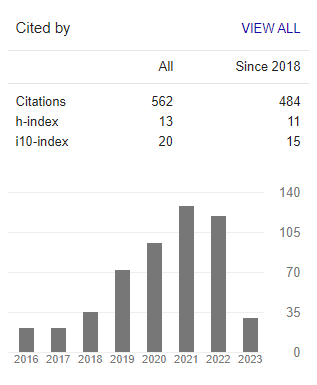“AM I CREATIVE ENOUGH OR PERFECTLY CHARMING?” Gender Comparison of How Millennials Represent themselves on Instagram
Abstract
Photos uploaded by the millennial generation are the process of re-purposing the means of photography in the form of self-representation as a way to construct their identity. This self-identity construction process also involves gender roles related facts that demonstrate various behaviors in the social media use. Photos posted as self-representation are not only getting a normative or supportive response in the caption as a comment or like, but also bringing up cases and problems. This article figures out the gender comparison in the self-identity construction of the millennial generation in social media Instagram. The netnography (virtual ethnography) method used to interpret the phenomenon of the daily behavior of the millennial generation on Instagram. Primary data derived from hypertext interactions with the millennial generation of Instagram users. The findings point that the male millennial prefer to present themselves as an intimate and friendly person who is close to the family in daily life. They are also more oriented towards presenting their preferences and hobbies by visualizing symbols related to them, such as highlighting creativity with tools used as photo and video cameras. While the female millennial tend to dislike daily show because it is considered a private matter. However, they like to show their identity through fashion or clothing known as OOTD, highlight their creative products, and more focus on themselves.
To cite this article (7th APA style):
Sosiawan, E. A. & Wibowo, R. (2021). "Am I creative enough or perfectly charming?" Gender comparison of how millennials represent themselves on Instagram. Journal Communication Spectrum: Capturing New Perspectives in Communication, 11(1), 64-73. http://dx.doi.org/10.36782/jcs.v1i1.2151
Keywords
References
Arymami, D. (2020). Spornosexual Capital: The Economic Crisis of Indonesian Urban Masculinity. I-Pop: International Journal of Indonesian Popular Culture and Communication, 1(1), 13-20. https://doi.org/10.36782/i-pop.v1i1.27
Beauvoir, S. (2009) [1949]. The Second Sex. Trans. Constance Borde and
Sheila Malovany-Chevallier. Random House: Alfred A. Knopf.
Berger, P. L., & Luckmann, T. (1991). The social construction of reality: A treatise in the sociology of knowledge. Penguin Books. (Original work published 1966)
Brenner, J. (2012, March). Social networking. Pew Research Center. https://pewinternet.org/Commentary/2012/March/Pew-Internet-Social-Networking-full-detail.aspx
Charon, J. M. (1998). Symbolic interactionism: An introduction, an interpretation, an integration (6th ed.). Prentice Hall.
Friedman, H. S., & Schustack, M. W. (2016). Personality: Classic theories and modern research (6th ed.). Prentice-Hall.
Giddens, A. (1991). Modernity and self-identity: Self and society in the late modern age. Polity Press/Blackwell Publishing.
Hall, S. (1996). Introduction: Who needs 'identity? In S. Hall & P. D. Gay (Eds.), Questions of cultural identity (pp. 1-17). SAGE Publications.
Hertlein, K. M. & Blumer, M. L. (2013). The couple and family technology framework: Intimate relationships in a digital age. Routledge.
Hill, D. T. & Sen, K. (2005). The internet in Indonesia's new democracy. Routledge.
Howe, N. & Strauss, W. (1991). Generations: The History of America's Future, 1584 to 2069. William Morrow & Company
Kozinets, R. V. (2009). Netnography: Doing ethnographic research online. SAGE Publications.
Lenhart, A., Purcell, K., Smith, A., & Zickuhr, K. (2010, February 3). Social media & mobile internet use among teens and young adults. Pew Research Center. https://www.pewresearch.org/internet/wp-content/uploads/sites/9/media/Files/Reports/2010/PIP_Social_Media_and_Young_Adults_Report_Final_with_toplines.pdf
Mannheim, K. (1952). The problem of generation. In P. Kecskemeti (Ed.), Essays on the sociology of knowledge (pp. 276-320). Routledge & Kegan Paul.
Montoya, P., & Vandehey, T. (2002). The personal branding phenomenon: Realize greater influence, explosive income growth, and rapid career advancement by applying the branding techniques of Michael, Martha & Oprah. Peter Montoya.
Nurul, D. T. S. (2015). Dari Follow Turun ke Hati: Upaya Media Sosial Internal JakunUB Menyentuh Kognisi, Afeksi, dan Konasi Mahasiswa Universitas Bakrie. Journal Communication Spectrum: Capturing New Perspectives in Communication, 5(2), 116-130
Prensky, M. (2001). Digital natives, digital immigrants Part 1. On the Horizon, 9(5), 1-6. https://doi.org/10.1108/10748120110424816
Purwadi, D. H. (1997). Belajar sendiri: Mengenal internet jaringan informasi dunia. Elex Media Komputindo.
Rideout, V. J., Foehr, U. G., & Roberts, D. F. (2010, January 1). Generation M2: Media in the Lives of 8- to 18-Year-Olds. Kaiser Family Foundation. https://www.kff.org/other/poll-finding/report-generation-m2-media-in-the-lives/
Selwyn, N. (2009). The digital native – myth and reality. Aslib Proceedings, 61(4), 364-379. https://doi.org/10.1108/00012530910973776
Smith, A. & Anderson, M. (2018, March 1). Social Media Use in 2018. Pew Research. https://www.pewresearch.org/internet/2018/03/01/social-media-use-in-2018/
Tapscott, D. (2008). Grown-up digital: How the net generation is changing your world. McGraw-Hill.
Refbacks
- There are currently no refbacks.

This work is licensed under a Creative Commons Attribution 3.0 License.
Indexed by:
Archived in:
Listed in:
INTERNATIONAL ASSOCIATION FOR MEDIA AND COMMUNICATION RESEARCH


















